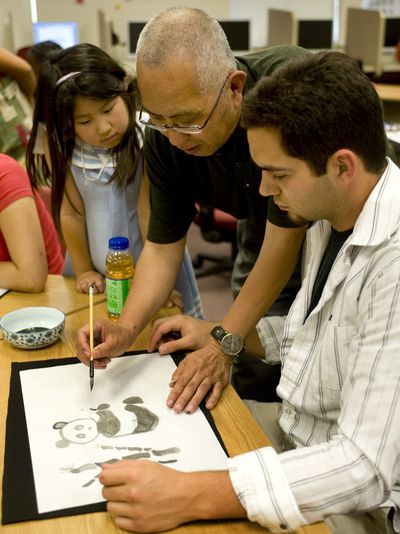Building the skills for a global future
Grant funds language classes

Michael Beck enrolled in the Mandarin Chinese class offered this summer at Gonzaga University because he thinks it will benefit his future career.
The 20-year-old Whitworth sophomore, a political science and business major, says speaking Chinese puts a person at the top of the list
“U.S. and China have huge political ties,” Beck said. “Professors told me if I have a background in Chinese, then it really helps.”
The grant-supported course is part of a federal initiative for Americans to learn languages considered important to the country’s future.
The idea is to “promote learning and understanding of languages and understanding of languages that are less commonly taught in schools,” said Gonzaga professor Bin Cheng, who helped land the $48,140 grant for Spokane. The instruction is considered “vital to ensure U.S. security interests, maintain economic competitiveness, and foster intercultural understanding.”
The grant, titled Startalk, came easily to Spokane because the program’s targeted languages – Mandarin Chinese, Arabic, Persian and Urdu – are rarely taught in area secondary schools and are fading from higher education institutions, Cheng said. The grant pays for half the course’s tuition. The cost to students is $370, which covers books, lab fee and lunches.
The Chinese instructor thinks she’ll be able to easily win the grant again next summer.
The courses are primarily directed at high school juniors and seniors, but others – like Beck – can enroll. The six-week program is 96 hours, and students spend four hours Monday through Thursday learning the language and the culture.
On Wednesday, students learned about Chinese watercolor using traditional ink and brushes – just one of the many cultural aspects taught thus far.
Beck said learning the culture helps with understanding the language. For example, the symbol for home has a shape like a roof with pig shape underneath it. The most prosperous in China were sometimes identified as those who could afford large quantities of pork, Beck said.
Caitlin Hess, a University High School junior, is an example of the young students the Startalk program hopes to reach. One of its goals is to teach the language early on so people have a better chance of becoming fluent.
“The earlier I learn it, the better I can get at it,” Hess said. Also, “I was worried about a college class moving too fast.”
The hardest part about learning Mandarin is the tone variations of a word, she said. For example, mom becomes horse when emphasized differently.
Caitlin thought about being an interpreter for a while, she said. But now she’s not sure what she’ll do. She does know that no matter what, knowing Chinese will help her.
“Obviously, China is a growing power and it will grow more and more,” Hess said.